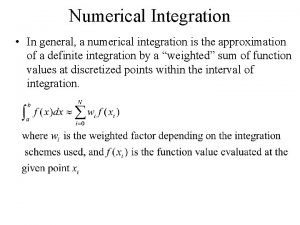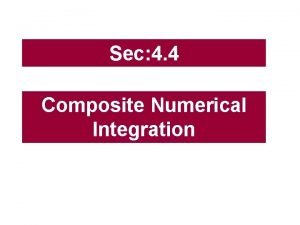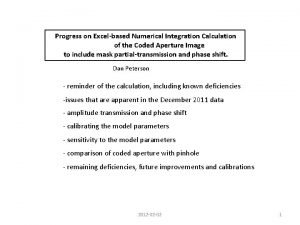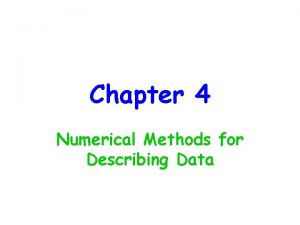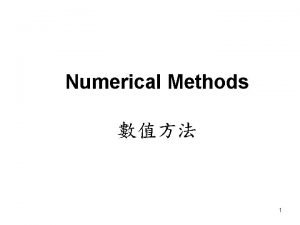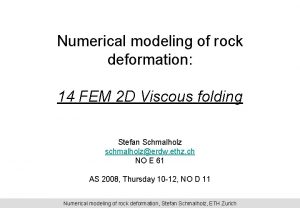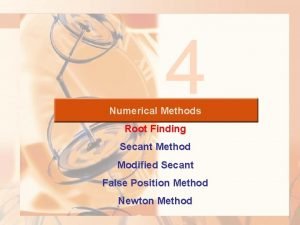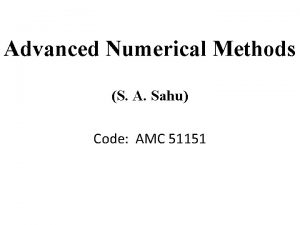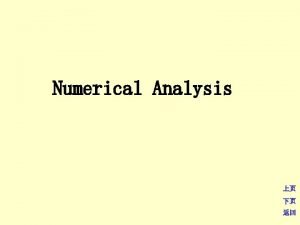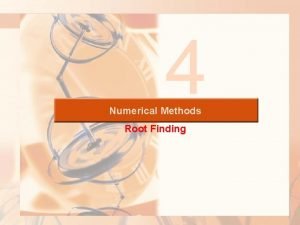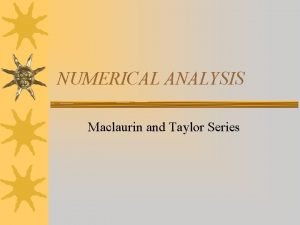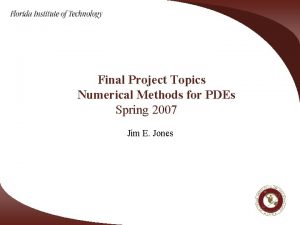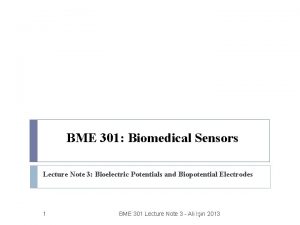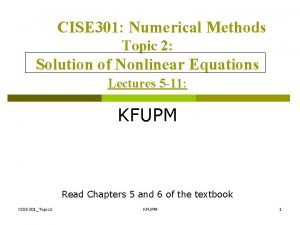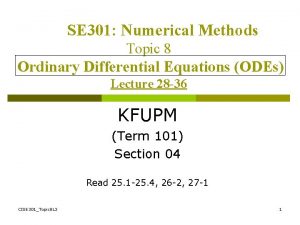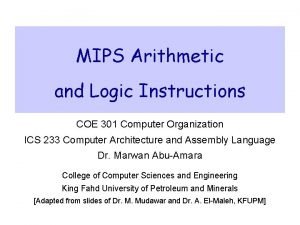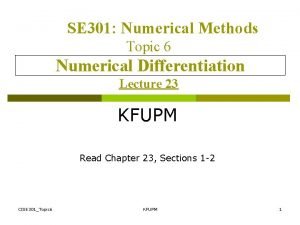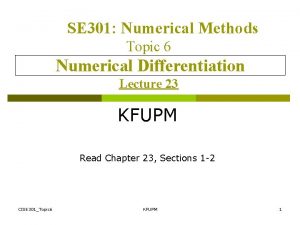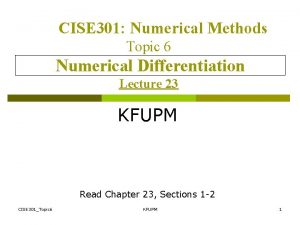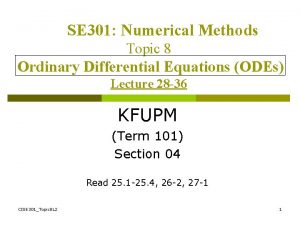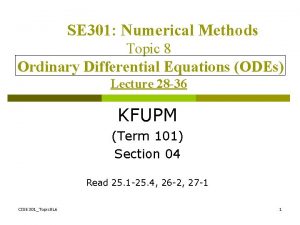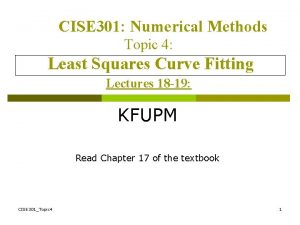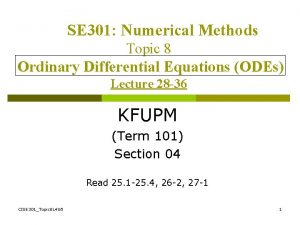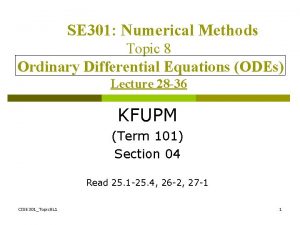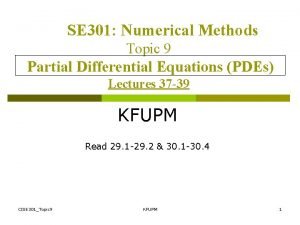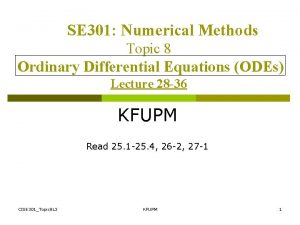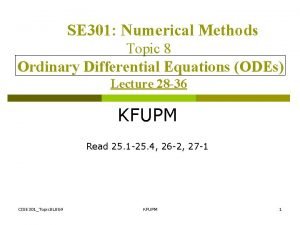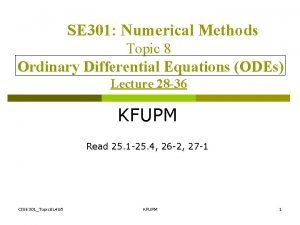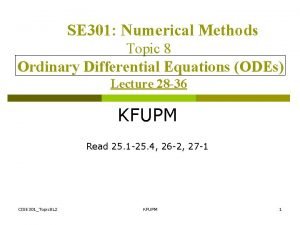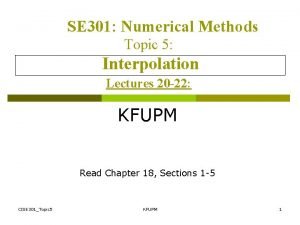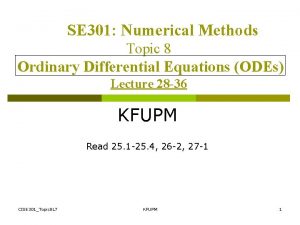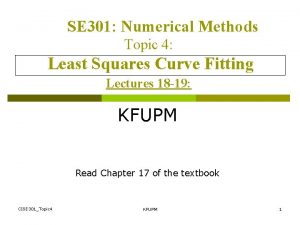SE 301 Numerical Methods Topic 7 Numerical Integration



















































- Slides: 51

SE 301: Numerical Methods Topic 7 Numerical Integration Lecture 24 -27 KFUPM (Term 101) Section 04 Read Chapter 21, Section 1 Read Chapter 22, Sections 2 -3 CISE 301_Topic 7 1

Lecture 24 Introduction to Numerical Integration p p p Definitions Upper and Lower Sums Trapezoid Method (Newton-Cotes Methods) Romberg Method Gauss Quadrature Examples CISE 301_Topic 7 2

Integration Indefinite Integrals Definite Integrals Indefinite Integrals of a function are functions that differ from each other by a constant. Definite Integrals are numbers. CISE 301_Topic 7 3

Fundamental Theorem of Calculus CISE 301_Topic 7 4

The Area Under the Curve One interpretation of the definite integral is: Integral = area under the curve f(x) a CISE 301_Topic 7 b 5

Upper and Lower Sums The interval is divided into subintervals. f(x) a CISE 301_Topic 7 b 6

Upper and Lower Sums f(x) CISE 301_Topic 7 a b 7

Example CISE 301_Topic 7 8

Example CISE 301_Topic 7 9

Upper and Lower Sums • Estimates based on Upper and Lower Sums are easy to obtain for monotonic functions (always increasing or always decreasing). • For non-monotonic functions, finding maximum and minimum of the function can be difficult and other methods can be more attractive. CISE 301_Topic 7 10

Newton-Cotes Methods In Newton-Cote Methods, the function is approximated by a polynomial of order n. p Computing the integral of a polynomial is easy. p CISE 301_Topic 7 11

Newton-Cotes Methods n Trapezoid Method (First Order Polynomials are used) n Simpson 1/3 Rule (Second Order Polynomials are used) CISE 301_Topic 7 12

Lecture 25 Trapezoid Method p p Derivation-One Interval Multiple Application Rule Estimating the Error Recursive Trapezoid Method Read 21. 1 CISE 301_Topic 7 13

Trapezoid Method f(x) CISE 301_Topic 7 14

Trapezoid Method Derivation-One Interval CISE 301_Topic 7 15

Trapezoid Method f(x) CISE 301_Topic 7 16

Trapezoid Method Multiple Application Rule f(x) x a CISE 301_Topic 7 b 17

Trapezoid Method General Formula and Special Case CISE 301_Topic 7 18

Example Given a tabulated values of the velocity of an object. Time (s) 0. 0 1. 0 2. 0 3. 0 Velocity (m/s) 0. 0 10 12 14 Obtain an estimate of the distance traveled in the interval [0, 3]. Distance = integral of the velocity CISE 301_Topic 7 19

Example 1 CISE 301_Topic 7 Time (s) 0. 0 1. 0 2. 0 3. 0 Velocity (m/s) 0. 0 10 12 14 20

Error in estimating the integral Theorem CISE 301_Topic 7 21

Estimating the Error For Trapezoid Method CISE 301_Topic 7 22

Example CISE 301_Topic 7 23

Example x 1. 0 1. 5 2. 0 2. 5 3. 0 f(x) 2. 1 3. 2 3. 4 2. 8 2. 7 CISE 301_Topic 7 24

Example x 1. 0 1. 5 2. 0 2. 5 3. 0 f(x) 2. 1 3. 2 3. 4 2. 8 2. 7 CISE 301_Topic 7 25

Recursive Trapezoid Method f(x) CISE 301_Topic 7 26

Recursive Trapezoid Method f(x) Based on previous estimate Based on new point CISE 301_Topic 7 27

Recursive Trapezoid Method f(x) Based on previous estimate Based on new points CISE 301_Topic 7 28

Recursive Trapezoid Method Formulas CISE 301_Topic 7 29

Recursive Trapezoid Method CISE 301_Topic 7 30

Example on Recursive Trapezoid n h R(n, 0) 0 (b-a)= /2 ( /4)[sin(0) + sin( /2)]=0. 785398 1 (b-a)/2= /4 R(0, 0)/2 + ( /4) sin( /4) = 0. 948059 2 (b-a)/4= /8 R(1, 0)/2 + ( /8)[sin( /8)+sin(3 /8)] = 0. 987116 3 (b-a)/8= /16 R(2, 0)/2 + ( /16)[sin( /16)+sin(3 /16)+sin(5 /16)+ sin(7 /16)] = 0. 996785 Estimated Error = |R(3, 0) – R(2, 0)| = 0. 009669 CISE 301_Topic 7 31

Advantages of Recursive Trapezoid: p Gives the same answer as the standard Trapezoid method. p Makes use of the available information to reduce the computation time. p Useful if the number of iterations is not known in advance. CISE 301_Topic 7 32

Lecture 26 Romberg Method p p p Motivation Derivation of Romberg Method Example When to stop? Read 22. 2 CISE 301_Topic 7 33

Motivation for Romberg Method p Trapezoid formula with a sub-interval h gives an error of the order O(h 2). p We can combine two Trapezoid estimates with intervals h and h/2 to get a better estimate. CISE 301_Topic 7 34

Romberg Method First column is obtained using Trapezoid Method R(0, 0) R(1, 1) R(2, 0) R(2, 1) R(2, 2) R(3, 0) R(3, 1) R(3, 2) R(3, 3) The other elements are obtained using the Romberg Method CISE 301_Topic 7 35

First Column Recursive Trapezoid Method CISE 301_Topic 7 36

Derivation of Romberg Method CISE 301_Topic 7 37

Romberg Method R(0, 0) R(1, 1) R(2, 0) R(2, 1) R(2, 2) R(3, 0) R(3, 1) R(3, 2) CISE 301_Topic 7 R(3, 3) 38

Property of Romberg Method R(0, 0) R(1, 1) R(2, 0) R(2, 1) R(2, 2) R(3, 0) R(3, 1) R(3, 2) R(3, 3) Error Level CISE 301_Topic 7 39

Example 0. 5 3/8 1/3 CISE 301_Topic 7 40

Example (cont. ) CISE 301_Topic 7 0. 5 3/8 1/3 11/32 1/3 41

When do we stop? CISE 301_Topic 7 42

Lecture 27 Gauss Quadrature p p Motivation General integration formula Read 22. 3 CISE 301_Topic 7 43

Motivation CISE 301_Topic 7 44

General Integration Formula CISE 301_Topic 7 45

Lagrange Interpolation CISE 301_Topic 7 46

Example p Determine the Gauss Quadrature Formula of If the nodes are given as (-1, 0 , 1) p Solution: First we need to find l 0(x), l 1(x), l 2(x) p Then compute: CISE 301_Topic 7 47

Solution CISE 301_Topic 7 48

Using the Gauss Quadrature Formula CISE 301_Topic 7 49

Using the Gauss Quadrature Formula CISE 301_Topic 7 50

Improper Integrals CISE 301_Topic 7 51
 Numerical
Numerical Composite simpsons rule
Composite simpsons rule Setprecision in c++
Setprecision in c++ Weddle rule formula
Weddle rule formula Asu
Asu Numerical integration in excel
Numerical integration in excel Chronicle of higher education
Chronicle of higher education Numerical methods
Numerical methods Different types of errors in numerical methods
Different types of errors in numerical methods Numerical methods for partial differential equations eth
Numerical methods for partial differential equations eth Numerical methods of descriptive statistics
Numerical methods of descriptive statistics Graphical method numerical analysis
Graphical method numerical analysis Relative true error formula
Relative true error formula Euler method
Euler method General solution of differential equation
General solution of differential equation Secant method to find root of equation
Secant method to find root of equation What is the value of w in laplace-everett formula
What is the value of w in laplace-everett formula Newton's forward difference formula
Newton's forward difference formula Interpolation in numerical methods
Interpolation in numerical methods What are numerical method in cfd
What are numerical method in cfd Birge vieta method uses formula of
Birge vieta method uses formula of Taylor series numerical methods
Taylor series numerical methods Pde project topics
Pde project topics Narrow
Narrow Clincher in writing
Clincher in writing Forward integration and backward integration
Forward integration and backward integration Forward and backward integration
Forward and backward integration Simultaneous integration
Simultaneous integration Quote weaving examples
Quote weaving examples System integration plan
System integration plan Seamless quote example
Seamless quote example Integration methods
Integration methods System integration methods
System integration methods Direct and indirect wax pattern
Direct and indirect wax pattern Dr sujan ali
Dr sujan ali Propogation
Propogation Inst 301
Inst 301 Ericsson bkv-301-216/130
Ericsson bkv-301-216/130 When to stop iterations in bisection method
When to stop iterations in bisection method Sa se imparta numarul 301
Sa se imparta numarul 301 Bioc 301
Bioc 301 Si-301
Si-301 Heun's method formula
Heun's method formula Coe 301
Coe 301 Ppl 301
Ppl 301 Coe 301 kfupm
Coe 301 kfupm Nagwa
Nagwa Cmnalle/301
Cmnalle/301 Ec 301
Ec 301 Mult mips
Mult mips Grundfos mobile interface
Grundfos mobile interface Conditional move assembly
Conditional move assembly
